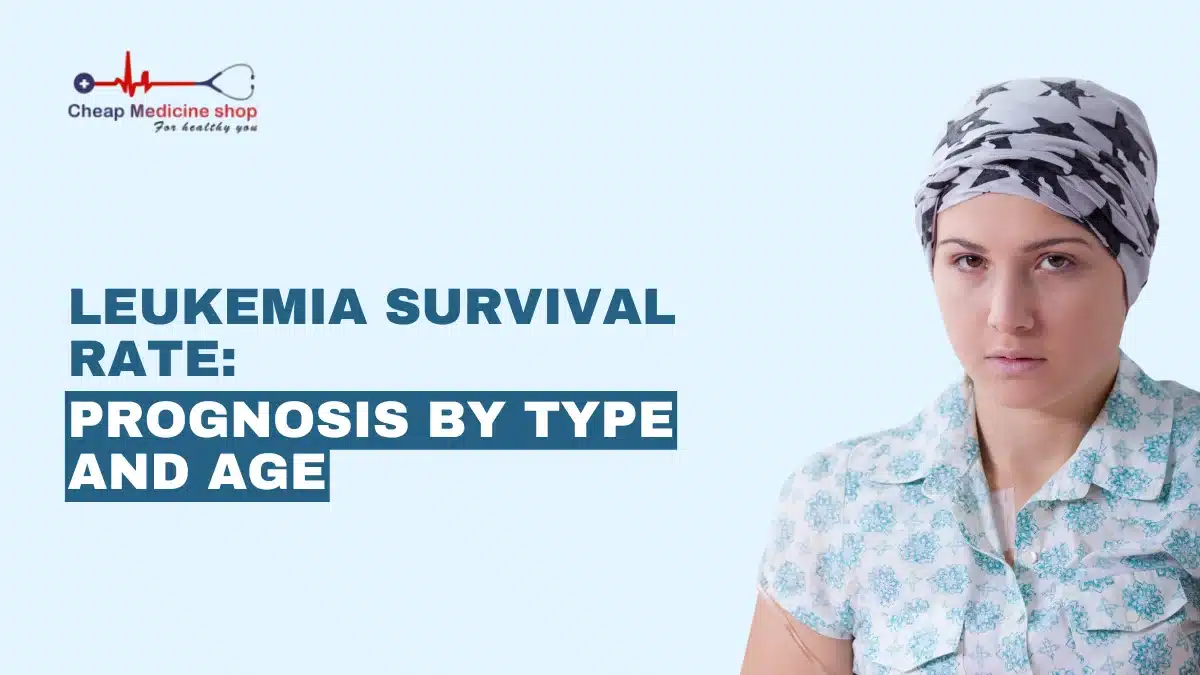Being diagnosed with Leukemia marks the beginning of a journey filled with uncertainty, tough decisions, and countless questions. One of the most pressing concerns for many patients is: “What are my chances of beating or surviving this disease?”
Leukemia survival rates have improved dramatically over recent decades thanks to medical advances. Today, many patients live long, fulfilling lives after diagnosis. However, survival statistics vary significantly based on Leukemia type, patient age, overall health, and treatment response. Understanding these statistics can provide a valuable perspective during your treatment journey.
Read on as this article looks into Leukemia survival rates and the key factors affecting prognosis, helping you navigate this challenging diagnosis with accurate information.
Overall Leukemia survival rates
The overall 5-year relative survival rate for Leukemia has improved dramatically, from just 34% in the mid-1970s to approximately 70% for 2013 to 2019.
This remarkable improvement reflects decades of research leading to targeted therapies, improved chemotherapy protocols, and advances in stem cell transplantation.
However, this overall figure masks significant variations between different Leukemia types.
Save up to 90% on your medicine bills

Abraxane 100 Mg Injection

Alphalan 5 Mg Tablets

Adriamycin 50 Mg Injection

Abirapro 250 Mg Tablet
Leukemia survival rate by age
Leukemia comes in four main types, each with distinct survival patterns:
Acute Lymphoblastic Leukemia survival rate
The overall 5-year survival rate for Acute Lymphoblastic Leukemia (ALL) has significantly improved over the decades, reaching approximately 72% since 2010.
Children under age 15 now have the most favorable outcomes, with a remarkable 93% survival rate. Adolescents (15–19 years) achieve about 74%, while young adults aged 20–29 and 30–39 see rates of 59%. Survival declines with age, dropping to around 43% for those aged 40–59 and below 30% for patients 60 and older.
These improvements reflect decades of treatment advances, including targeted therapies and optimized care strategies.
Acute Myeloid Leukemia (AML) survival rate
Acute Myeloid Leukemia generally shows lower survival rates compared to ALL.
The overall 5-year relative survival rate for AML is approximately 32.9%, based on data from 2015 to 2021. Young adults under 45 tend to have better outcomes, while those between 45 and 64 experience moderate survival. Elderly patients over 65 face the greatest challenge, with significantly lower survival rates.
In 2025, an estimated 22,010 new cases are expected, accounting for 1.1% of all Cancer diagnoses, with 11,090 projected deaths, representing 1.8% of Cancer-related mortality. New targeted therapies have begun improving outcomes for certain AML subtypes with specific genetic mutations, offering hope for better future statistics.
Chronic Lymphocytic Leukemia survival rate
Chronic Lymphocytic Leukemia (CLL) has one of the most favorable outcomes among Leukemia types, with a 5-year relative survival rate of 89.3% (2015–2021). Survival has steadily improved over the decades, now nearing 94.5% in recent years. CLL typically progresses slowly, often not requiring immediate treatment.
Many patients live for years after diagnosis; some may never need treatment. In 2022, an estimated 226,432 people lived with CLL in the U.S., with a lifetime risk of 0.6%. The annual rate of new cases is about 4.7 per 100,000 people, and the death rate is approximately 1.1 per 100,000.
Chronic Myeloid Leukemia (CML) survival rate
The overall 5-year relative survival rate for CML is 70.6%. Survival rates vary significantly by age: patients under 50 have a 90.6% survival rate, while those aged 50-64 and 65+ show rates of 81.2% and 50.3%, respectively. The survival rate differs slightly by gender, 72.4% for females and 69.4% for males.
Targeted therapies, particularly Tyrosine Kinase Inhibitors (TKIs), have revolutionized Chronic Myeloid Leukemia treatment since the early 2000s, improving survival rates more than tripling since the 1970s.
Childhood Leukemia survival rates

The 5-year survival rate for children with ALL has increased over time to about 90% overall. Children in lower-risk groups have even better outcomes, though even those in higher-risk groups can often still be cured. For AML, overall 5-year survival rates have improved to 65-70%, though rates vary by subtype. Acute Promyelocytic Leukemia (APL), a subtype of AML, now has cure rates exceeding 80%.
For rarer childhood Leukemias, Juvenile Myelomonocytic Leukemia (JMML) has reported 5-year survival rates of approximately 50%. CML, though rare in children, historically showed 5-year survival rates of 60-80%, but newer targeted therapies have likely improved these outcomes substantially in recent years.
Important factors affecting Leukemia prognosis
While age and Leukemia type provide baseline expectations, many other factors influence individual outcomes:
- Genetic mutations: Specific gene changes can make Leukemia more or less responsive to treatment.
- White blood cell count at diagnosis: Very high counts may indicate more aggressive disease.
- Response to initial treatment: How quickly Leukemia responds to therapy predicts long-term outcomes.
- Minimal Residual Disease (MRD): Tiny amounts of remaining Leukemia cells detected after treatment.
- Overall health: Patients with fewer other health problems typically tolerate treatment better.
- Access to specialized care: Treatment at comprehensive Cancer centers may improve outcomes.
Conclusion
Leukemia survival rates have improved dramatically over recent decades, offering hope to newly diagnosed patients. While the overall 5-year survival rate now approaches 70%, outcomes vary significantly based on Leukemia type, patient age, and individual risk factors. Children and younger adults generally face better prognoses, particularly with ALL, while older patients with AML face greater challenges.
These statistics provide a helpful perspective, but cannot predict individual outcomes. Many patients outlive statistical expectations, and recent treatment breakthroughs may not yet be reflected in current survival data.
The most encouraging news is that survival rates continue improving across all Leukemia types as research advances. For patients diagnosed today, the outlook is more promising than ever, with new targeted therapies and immunotherapies expanding treatment options and improving quality of life.

Frequently Asked Questions
Is Leukemia 100% curable?
No, Leukemia isn’t considered 100% curable for most patients. However, many achieve long-term remission or functional cure, living Cancer-free for decades. Childhood ALL approaches 90% cure rates, while some adult Leukemias are increasingly managed as chronic conditions with ongoing treatment.
What is life like for someone with Leukemia?
Life with Leukemia varies by treatment phase and disease type. Patients face fatigue, infection risk, and treatment side effects during intensive treatment. Many later return to normal activities, though follow-up care continues. Some chronic Leukemia patients manage their disease with daily medication for years.
Can Leukemia go into remission without treatment?
No, Leukemia rarely goes into spontaneous remission without treatment. While some chronic Leukemias progress slowly without immediate treatment needs, acute Leukemias require prompt intervention. Without appropriate treatment, acute Leukemia typically progresses rapidly, leading to life-threatening complications within weeks to months.
What are the chances of Leukemia returning after remission?
Relapse risk varies by Leukemia type and individual factors. Childhood ALL has relapse rates of 15-20%, while adult AML relapse rates range from 30-70%. Risk factors include specific genetic mutations, poor initial treatment response, and measurable residual disease after therapy.
What is the Stage 4 Leukemia survival rate?
Stage 4 Leukemia isn’t defined like solid tumors. Instead, advanced Leukemia involves high-risk features such as CNS spread or genetic mutations. For acute cases with these features, 5-year survival rates range from 10–30%, though outcomes vary based on age, genetics, and treatment response.
Cheap Medicine Shop only refers to credible, authoritative sources for our content. If you’re curious about how we ensure the integrity of our content, we encourage you to read our Content Information Policy.












